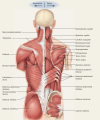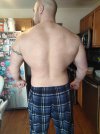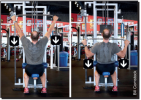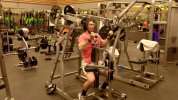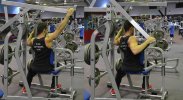D
Deleted member 123722
Guest
I learned these "lat pull-ins" from Doug Brignole; this exercise truly fries the lats without using the rear delts and bicep assistance.
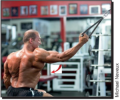
Moreover, this movement goes with the flow of the 45-fibers on the lats, pulling in toward the spine, rather from from the front of the body, which does not load the lats that efficiently compared to these. Pulling from the front involves too much rear delts, biceps, and forearms... you all feel this after heavy pull downs or bent over rows (I used to pull 365 x 6), and you back isn't really that fried... Doing these, you'll be fried as fuck, without the systematic fatigue from all the compounds and pulls from the front of your body.
After reading Doug's Brignoles book, and applying his ideas, I literally only do these two exercises for back now: lat pull ins and "scapular retractions" which act as a low row, but targets the middle traps and "upper" back. Both of these movements are shown in the video below. But I do the lat pull in from a higher angle
But because I hit back twice as week, I also do my own variation of these using the hammer strength machines, both the high row (supinated grip), and middle row (a hammer grip); all I do to make these more effective is angle my body in the chair at 45-degrees and pull in. Basically, every back movement should be pulling in from 45 degrees, rather than pulling back from the front.
So when I do my first back workout, I use the hammer machines with heavy weight; then workout two, I will use cable movements for variation. This isn't necessary, but I like doing more variation.
I only do 4 sets for each exercises (8 total) per session, and I hit back twice a week. (16 total sets).
If you don't believe me, try them yourselves.
View: https://www.youtube.com/watch?v=B_EKdWyOj7M&ab_channel=RenzoAlgieri

Moreover, this movement goes with the flow of the 45-fibers on the lats, pulling in toward the spine, rather from from the front of the body, which does not load the lats that efficiently compared to these. Pulling from the front involves too much rear delts, biceps, and forearms... you all feel this after heavy pull downs or bent over rows (I used to pull 365 x 6), and you back isn't really that fried... Doing these, you'll be fried as fuck, without the systematic fatigue from all the compounds and pulls from the front of your body.
After reading Doug's Brignoles book, and applying his ideas, I literally only do these two exercises for back now: lat pull ins and "scapular retractions" which act as a low row, but targets the middle traps and "upper" back. Both of these movements are shown in the video below. But I do the lat pull in from a higher angle
But because I hit back twice as week, I also do my own variation of these using the hammer strength machines, both the high row (supinated grip), and middle row (a hammer grip); all I do to make these more effective is angle my body in the chair at 45-degrees and pull in. Basically, every back movement should be pulling in from 45 degrees, rather than pulling back from the front.
So when I do my first back workout, I use the hammer machines with heavy weight; then workout two, I will use cable movements for variation. This isn't necessary, but I like doing more variation.
I only do 4 sets for each exercises (8 total) per session, and I hit back twice a week. (16 total sets).
If you don't believe me, try them yourselves.
View: https://www.youtube.com/watch?v=B_EKdWyOj7M&ab_channel=RenzoAlgieri


